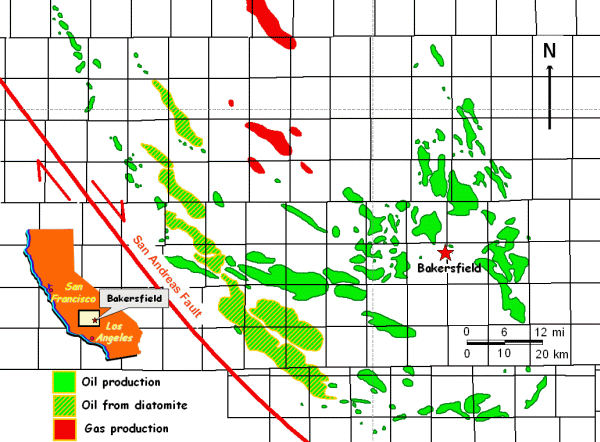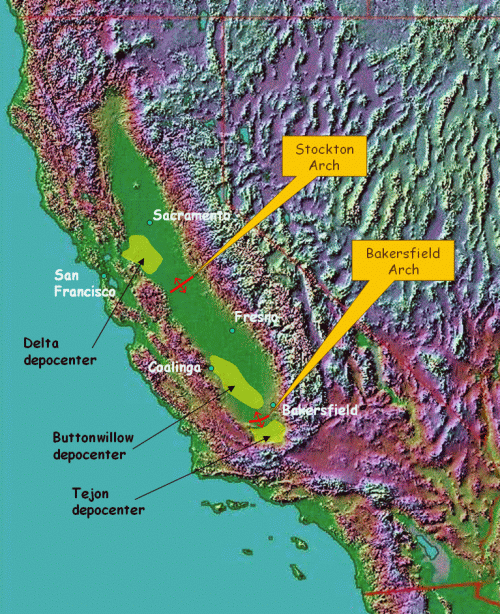|
Oil Geology of the San Joaquin Valley
A trap is going to made up of a seal at the top - such as an impermable shale, and a configuration that provides seals at the sides to allow the oil to accumulate. If enough oil accumulates, then the resulting subsurface pool might be an economic target worth drilling a well into. Traps generally exist in predictable places - such as at the tops of anticlines, next to faults, in the updip pinchouts of sandstone beds, or beneath unconformities. However, there are always exceptions. To find a convergence in the subsurface of the geologic elements necessary to form an oil or gas pool requires a careful blend of science and art. To discover what geometries and compositions the rocks might possess deep underground, geologists examine the rocks where they are exposed in surface outcrops, or they examine aerial photographs and satellite images when surface access is limited. And of course they study the surrounding wells that have already been drilled, hoping to find clues as to where the oil is hidden in the subsurface. The old timers relied heavily on microfossil data from both wells and outcrop to interpret the subsurface. These days, micropaleontology has taken a back seat to seismic data as the tool of choice for figuring out what source rocks, seals and reservoirs are present in the subsurface. Seismic data also gives clues as to the geometries of rock layers in the subsurface. Thus, most geologists today work closely with geophysicists to integrate seismic lines and other types of geophysical data into their interpretations. Over the last 150 years geologists and geophysicists with the help of paleontologists, engineers and other disciplines have located more than onr hundred oil and gas fields in the San Joaquin Valley, many of which are shown below. And of course the industry is always looking for more fields, but the reality is that new fields are getting harder and harder to find. Nonetheless the search continues.
Source Rocks of the San Joaquin Valley Back in the late 1800s and early 1900s one of the great debates in the petroleum industry was whether oil was organic, or inorganic in origin. In other words, some argued that oil was derived from dead and decaying plant and animal matter, whereas others argued that oil was primordial, which means it was a left over from inorganic chemical processes associated with the creation of the universe. However, today it is pretty well accepted that oil and gas are organic, and that virtually all of the hydrocarbons that we produce from the earth originally came from organic-rich, black shales, which are said to the "source rocks" for these hydrocarbons. The turning point in the organic versus inorganic oil controversy in California came about in 1907 when Ralph Arnold published a paper that showed that oils in the Santa Maria Basin were probably derived from diatoms in the Miocene Monterey Shale. Later publications by other geologists then showed that the Santa Maria oils geochemically were very, very similar to the diatom-derived organic matter in the Monterey. Over the years the body of evidence has grown, and there is really no question now that virtually all of the hydrocarbons that we extract from the San Joaquin Valley are organic, hence we refer them as "fossil fuels".
The oil-generating organic matter that is found in the black shales of the San Joaquin Valley is composed largely of marine plankton (Type II organic matter), such as diatoms, which floated on or near the surface of the ancient San Joaquin Valley sea. When these organisms died, they sank and accumulated in an oxygen-deficient environment on the ancient sea floor. Next the solid organic matter was deeply buried by sediment and slowly converted by the integrated effects of time and temperature into liquid oil and gas. This is done mainly by breaking up the large, complex hydrocarbon molecules that make up the organic matter into the smaller, simpler molecules that characterize oil. The integrated effects of time and temperature mean that either a lot of heat for a short amount of time, or a small amount of heat for a long period of time will do the trick. Geochemists are able to use organic compounds called biomarkers, as well as carbon isoptopes, to "fingerprint" oils, and sometimes gas, to determine the source rocks the oils came from. Biomarker studies have identified the following source rocks for the San Joaquin Valley.
Most oils in the San Joaquin Valley are derived from Mohnian-age Monterey source rocks. Next in importance would be oils derived from the Eocene Kreyenhagen Shale. Interestingly, the Sacramento Valley is a gas province, with very little oil, in which the gas derives from the Upper Cretaceous Dobbins, Winters and Sacramento Shales (Forbes Formation). These shales are similar in age to the Moreno shale of the San Joaquin Valley, but contain different types of organic matter, with more land-derived plant material (Type III organic matter) and less planktonic (Type II organic matter). Because depocenters are where sediments in a basin are buried deepest, depocenters are where source rocks will absorb the most heat. Thus, depocenters are where oil generates first, and oil will migrate from the depocenters into the arches and valley margins. The map below shows the depocenters and arches of the Great Valley. The Buttonwillow and Tejon depocenters source the oils of the San Joaquin Valley, and the Delta (Rio Vista) depocenter sources the gas of the Sacramento Valley.
 History of the Oil Industry
History of the Oil Industry

 How to find Oil and Gas
How to find Oil and Gas

 How to make Gasoline
How to make Gasoline

 McKittrick Tar Pits
McKittrick Tar Pits

 What is Oil?
What is Oil?

 Oil Facts
Oil Facts

|
|

 Several geologic elements are necessary for oil and gas to accumulate in sufficient quantities to create a pool large enough to be worth producing. These elements include an organic-rich
Several geologic elements are necessary for oil and gas to accumulate in sufficient quantities to create a pool large enough to be worth producing. These elements include an organic-rich 



